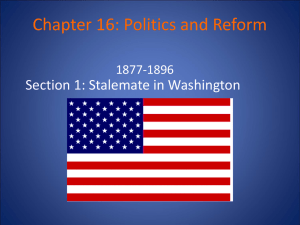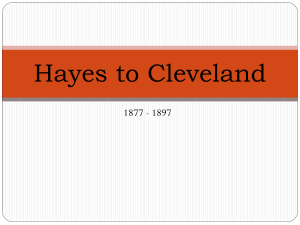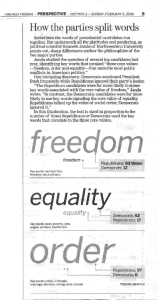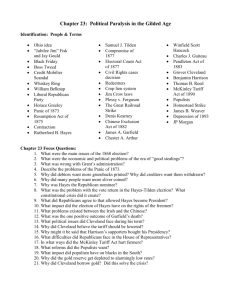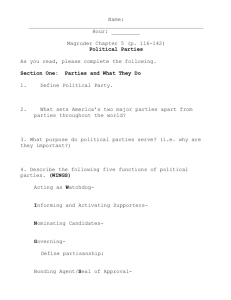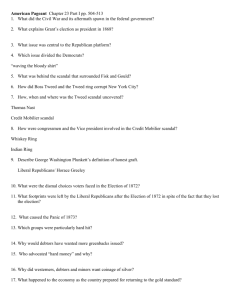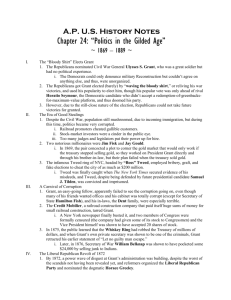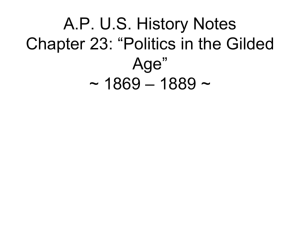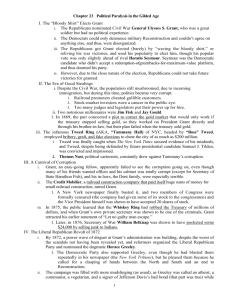File
advertisement
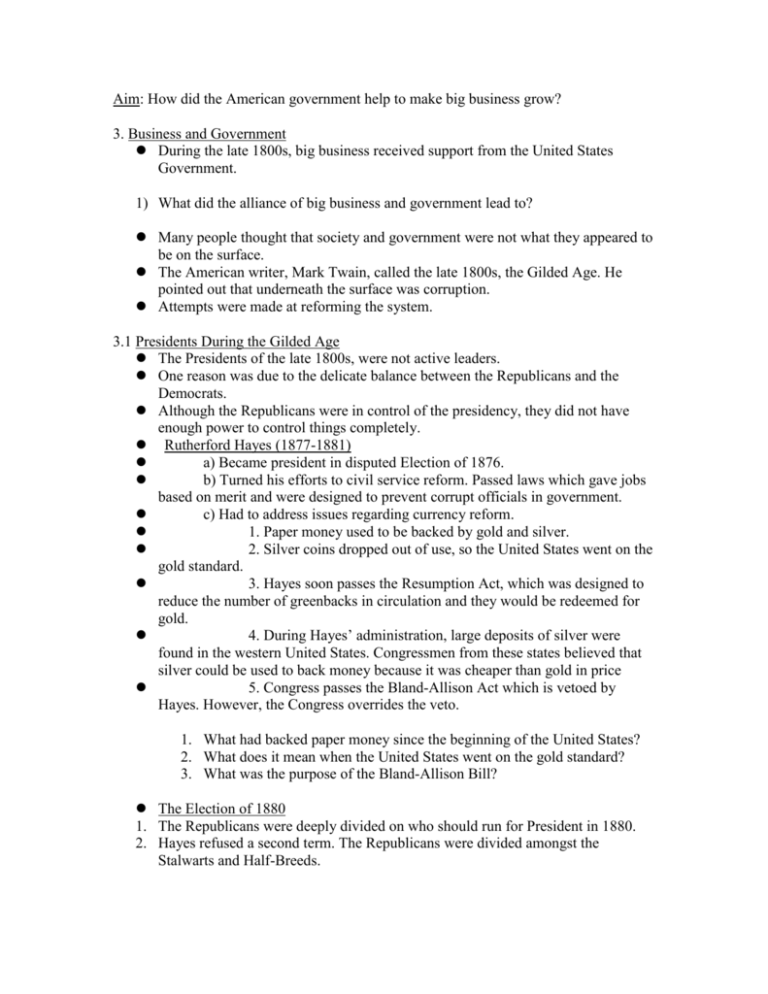
Aim: How did the American government help to make big business grow? 3. Business and Government During the late 1800s, big business received support from the United States Government. 1) What did the alliance of big business and government lead to? Many people thought that society and government were not what they appeared to be on the surface. The American writer, Mark Twain, called the late 1800s, the Gilded Age. He pointed out that underneath the surface was corruption. Attempts were made at reforming the system. 3.1 Presidents During the Gilded Age The Presidents of the late 1800s, were not active leaders. One reason was due to the delicate balance between the Republicans and the Democrats. Although the Republicans were in control of the presidency, they did not have enough power to control things completely. Rutherford Hayes (1877-1881) a) Became president in disputed Election of 1876. b) Turned his efforts to civil service reform. Passed laws which gave jobs based on merit and were designed to prevent corrupt officials in government. c) Had to address issues regarding currency reform. 1. Paper money used to be backed by gold and silver. 2. Silver coins dropped out of use, so the United States went on the gold standard. 3. Hayes soon passes the Resumption Act, which was designed to reduce the number of greenbacks in circulation and they would be redeemed for gold. 4. During Hayes’ administration, large deposits of silver were found in the western United States. Congressmen from these states believed that silver could be used to back money because it was cheaper than gold in price 5. Congress passes the Bland-Allison Act which is vetoed by Hayes. However, the Congress overrides the veto. 1. What had backed paper money since the beginning of the United States? 2. What does it mean when the United States went on the gold standard? 3. What was the purpose of the Bland-Allison Bill? The Election of 1880 1. The Republicans were deeply divided on who should run for President in 1880. 2. Hayes refused a second term. The Republicans were divided amongst the Stalwarts and Half-Breeds. 3. Ulysses S. Grant and James G. Blaine become the leading candidates, however, the Republicans turn to James Garfield and Chester Arthur for the nomination. 4. The Democrats turn to Winfield Scott and run on a platform of civil service reform and a lower tariff. 5. The Election of 1880 was close. Garfield received 214 electoral votes, Scott received 155. 4) Who were the Half-Breeds? the Stalwarts? 5) Who did the Republicans nominate for President in 1880? 6) If he was nominated and elected, Ulysses Grant would have been elected for a third term. Why would this occur without a problem? James Garfield and Chester Arthur 1-They are elected in 1880. 2-When they are inaugurated in 1881, they appointed Half-Breeds to many of the best jobs in the government. 3-This annoys the Stalwarts. As a result, the Stalwarts attacked him. 4-Four months into his first term, Garfield is shot and killed by a disappointed office seeker named Charles Guiteau. 5-Chester Arthur replaced James Garfield. As president, he refused to let the Stalwarts take the spoils of office. Arthur passed the Pendleton Act, which now made it mandatory for all government workers to take examinations for their jobs. 3.2 The Return of the Democrats In the Election of 1884, the Republican Party again was divided. The policies of Chester Arthur found favor with most Americans. However, these actions do not impress the Republicans. The Stalwarts chose James Blaine as their candidate even though he was corrupt. The problem was that the reformers of the Republican Party called muguwumps, refused to support him. They supported the Democratic candidate Grover Cleveland, who is the first Democratic President elected since James Buchanan. Grover Cleveland (1885-1889;1893-1897) 1. He is the 22nd and 24th president. 2. When he became President, Cleveland made changes. a. He added more jobs to the Pendleton Act. b. He reduced federal spending. c. He put 80,000,000 acres of land back under government control. d. He tried to get the tariff lowered. e. In 1887, he passed the Interstate Commerce Act, which established railroad regulations. f. He passed the Hatch Act 7) What did the Hatch Act provide? Cleveland’s policies drew criticism from both Democrats and Republicans. 1. Republicans believed he was limiting the power of the free enterprise system. 2. Democrats believed he was passing too many reforms, while others believed he was not passing enough reforms. Cleveland was nominated in 1888, but he lost in the general election to Benjamin Harrison. Cleveland would win re-election in 1892. 3.3 The Political Pendulum When Harrison defeated Cleveland in 1888, the political pendulum swung back to the Republicans. The Republicans ended many of Cleveland’s policies. Republicans gave political supporters jobs. The Republicans voted for pensions for Civil War veterans which Cleveland did not want. The Republicans pass the McKinley Tariff which raised the tariff to an all-time level high. Voters were angered by the Republicans and re-elected Cleveland. Voters also gave the Congress back to the Democrats. Cleveland did not have much time to enjoy his victory and the Democrats did not have any time to enjoy their popularity. 8) What happened to interfere with Cleveland’s popularity?
